Confronting the Modern Era
Getting a Fair Share
The Vote
The right to vote had been limited since the United States was formed. In fact, the U.S. Constitution doesn’t address it.
The common belief of that time was that only men who owned land had the independence to vote their belief and a stake in the outcome of that vote.
It didn’t take long for men who didn’t own land, and who had fought against “no taxation without representation,” to realize that they were once again being shut out.
As a result, states struggled with different ways to qualify voters. Men who owned property of a certain value were also given the vote. Tennessee’s constitution in 1796 gave the vote to all male citizens, white and black, who owned land in the state.
In the 1834 constitutional convention, delegates agreed that all men, regardless of property holdings, should be able to vote. But delegates also inserted the word “white” in describing who could vote, thus taking the vote away from free black men.
After the end of the Civil War, the 15th amendment to the U.S. Constitution was ratified giving black males the right to vote. For a brief period during Reconstruction, African Americans in the South voted, and served in elected office.
With the end of Reconstruction, black men lost many of the gains they had made. In Tennessee African Americans never completely lost the right to vote, but a new constitution passed in 1870 began a poll tax, a tax that had to be paid before a man could vote. This reduced the number of poor black and white people who could vote.
Women also wanted the right to vote. They began efforts that culminated with the passage of the 19th amendment giving voting rights to women. The final passage occurred in Nashville.
A Fair Income
There were several confrontations between owners and companies and the men who worked for them. These included strikes and sometimes outright violence. Miners in Anderson County had so much conflict over the use of convicts in the mines that this struggle is sometimes called convict wars.
Farmers, upset over low prices for their goods and high interest rates, attempted to organize in an alliance. This alliance had some success in passing laws giving farmers relief. Other farmers in Middle Tennessee and Kentucky went to war with each other and tobacco companies over efforts to hold prices down for dark-fired tobacco.
And finally, some laborers around Reelfoot Lake in upper West Tennessee resorted to violence to stop investors from draining part of the lake for development, which would take away their livehoods.
The right to vote had been limited since the United States was formed. In fact, the U.S. Constitution doesn’t address it.
The common belief of that time was that only men who owned land had the independence to vote their belief and a stake in the outcome of that vote.
It didn’t take long for men who didn’t own land, and who had fought against “no taxation without representation,” to realize that they were once again being shut out.
As a result, states struggled with different ways to qualify voters. Men who owned property of a certain value were also given the vote. Tennessee’s constitution in 1796 gave the vote to all male citizens, white and black, who owned land in the state.
In the 1834 constitutional convention, delegates agreed that all men, regardless of property holdings, should be able to vote. But delegates also inserted the word “white” in describing who could vote, thus taking the vote away from free black men.
After the end of the Civil War, the 15th amendment to the U.S. Constitution was ratified giving black males the right to vote. For a brief period during Reconstruction, African Americans in the South voted, and served in elected office.
With the end of Reconstruction, black men lost many of the gains they had made. In Tennessee African Americans never completely lost the right to vote, but a new constitution passed in 1870 began a poll tax, a tax that had to be paid before a man could vote. This reduced the number of poor black and white people who could vote.
Women also wanted the right to vote. They began efforts that culminated with the passage of the 19th amendment giving voting rights to women. The final passage occurred in Nashville.
A Fair Income
There were several confrontations between owners and companies and the men who worked for them. These included strikes and sometimes outright violence. Miners in Anderson County had so much conflict over the use of convicts in the mines that this struggle is sometimes called convict wars.
Farmers, upset over low prices for their goods and high interest rates, attempted to organize in an alliance. This alliance had some success in passing laws giving farmers relief. Other farmers in Middle Tennessee and Kentucky went to war with each other and tobacco companies over efforts to hold prices down for dark-fired tobacco.
And finally, some laborers around Reelfoot Lake in upper West Tennessee resorted to violence to stop investors from draining part of the lake for development, which would take away their livehoods.
Picture Credits:
- Photograph of the Black Patch Tobacco Association Parade taken September 24, 1904 in Guthrie, Kentucky. This photo shows the Black Patch float. It is shaped like a boat and has the words “C. H. Fort Captain,” listed on the side. The photo also shows men on board the float holding banners with one saying, “Adams is sailing with the Association.” Tennessee State Library and Archive.
- Photograph showing two miners. The men are shown seated on a railway car. This photo was created sometime between the 1880s and 1920s. Tennessee State Library and Archive.
- Photograph entitled, “The suffrage watchfire before the White House.” The photo shows four demonstrators from the National Women’s Party holding banners and standing beside a small fire in front of the White House. The protesters wanted Wilson to support women's suffrage. One of the banner reads, “President Wilson is deceiving the world when he appears as the prophet of democracy. President Wilson has opposed those who demand democracy for this county. He is responsible for the disfranchisement of millions of Americans. We in America know this. The world will find him out.” Library of Congress.
- Photograph showing a sawmill crew. The leader of the crew, James Lafayette Dyche II, is shown standing to the right of a horse with his hands in his pockets. This photo was taken in Bluff City, Tennessee in 1880. Tennessee State Library and Archive.
- Photograph of the Railway Employees Association. This photograph was taken in 1911. It shows the organizations president, Humphrey Bowling. Bowling is seated 3rd from the left on the first row. His wife, Rose Stoddard Bowling is seated directly behind him Tennessee State Library and Archive.
- Photograph of Reelfoot Lake. The image was taken in Obion County, Tennessee in 1922 and shows several buildings near the edge of the lake. Tennessee State Library and Archive.
- Photograph showing women in Chattanooga. This photo was taken on Gay street and shows numerous women dressed in winter coats. Tennessee State Museum Collection.
Confronting the Modern Era >> Life in Tennessee >> Getting a Fair Share >>
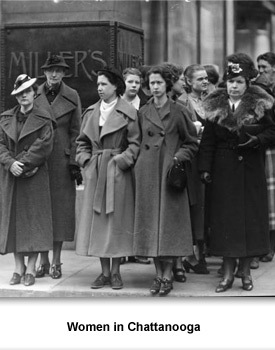
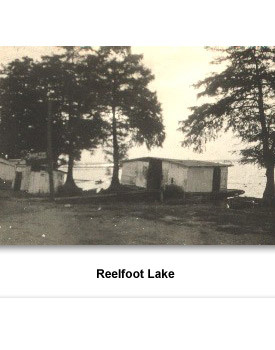
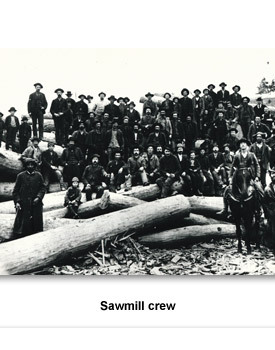
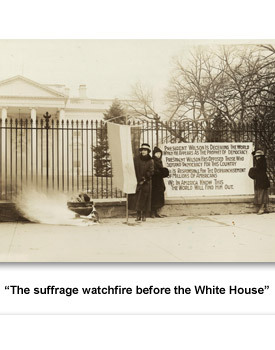
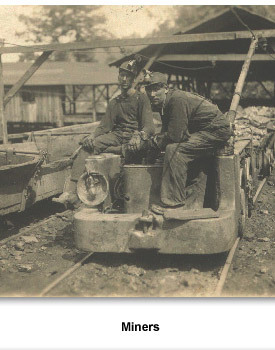
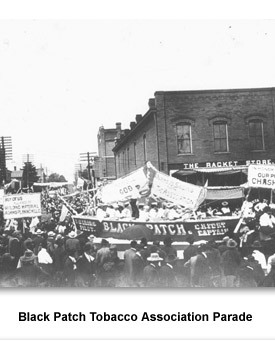
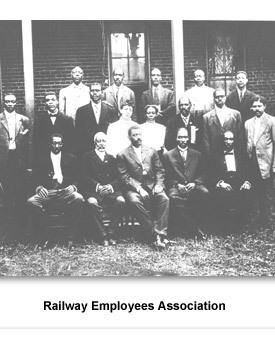
 Sponsored by: National Endowment for the Humanities
Sponsored by: National Endowment for the Humanities